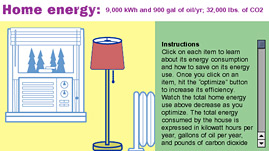Teachers' Domain - Digital Media for the Classroom and Professional Development
User: Preview


Source: FRONTLINE/NOVA: "What's Up with the Weather?" Web site
In many modern societies, simply going about one's daily activities consumes more of the world's non-renewable energy resources than you may have ever thought possible. Which of your activities and possessions do you think uses more resources? What can you do to limit this energy drain? In this interactive activity from the FRONTLINE/NOVA Web site see where energy is wasted in a typical American home and learn how to make your home more energy efficient.
The United States is responsible for one-quarter of the world's energy consumption, mostly from the burning of fossil fuels. These natural resources are non-renewable and are becoming increasingly difficult to access. In addition, the burning of fossil fuels impacts the environment and is a likely cause of global warming.
Earth's relatively warm and consistent surface temperature is the result of atmospheric gases causing what is known as the greenhouse effect. Carbon dioxide, which consists of one carbon atom with an oxygen atom bonded to each side, is one "greenhouse gas." When a carbon dioxide molecule absorbs infrared radiation, it vibrates. Eventually, the vibrating molecule will emit the radiation it has absorbed. Often this energy is passed to another greenhouse gas molecule. This absorption-emission-absorption cycle in the lower atmosphere keeps heat near Earth's surface, effectively insulating the planet from the cold of space.
Greenhouse gases include carbon dioxide, water vapor, methane, nitrous oxide, and a few other compounds. All these compounds are composed of more than two atoms, bound loosely enough together to vibrate when they absorb energy. In contrast, two other atmospheric gases, oxygen and nitrogen, exist as two-atom molecules. Bound tightly together, these atoms resist vibration and thus do not absorb and re-radiate heat and do not contribute to the greenhouse effect.
In the proper balance, greenhouse gases make life on Earth possible. However, any increase in the concentration of these gases poses the risk of altering the natural balance and changing global temperatures. Scientists estimate that the average temperature of the planet has increased by about one-half degree Celsius (one degree Fahrenheit) since 1880. Most hold human activities at least partly responsible for this increase.
Estimates suggest that every American is directly or indirectly responsible for the release of approximately 20 tons of CO2 into the air each year. Roughly one-third of this comes from automobiles. Heating and lighting our homes produces another large proportion of our total CO2 emissions. But what about video games, fish tanks, televisions, computers, and other nonessentials? This simulation identifies where energy loss occurs in the average American home and offers suggestions for reducing energy waste.
To learn more about the role CO2 plays in Earth's temperature, check out Global Warming: The Physics of the Greenhouse Effect and Global Warming: Carbon Dioxide and the Greenhouse Effect.
 Loading Standards
Loading Standards Teachers' Domain is proud to be a Pathways portal to the National Science Digital Library.
Teachers' Domain is proud to be a Pathways portal to the National Science Digital Library.
